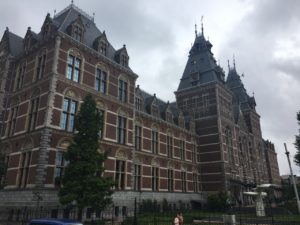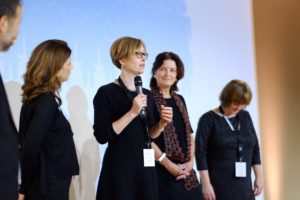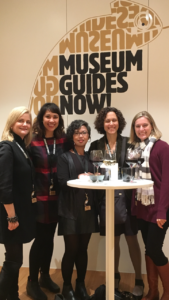Yes, and… Comfort and Discomfort in Museum Guide Programs
The topic of the current and future status of museum docent and guide programs (volunteer and paid) is a frequent conversation among colleagues in U. S. museums. How can we have a corps of educators that are representative of our country’s demographics with our current volunteer-based models? How are we ensuring learner-centered teaching and dialogue in museum tours? How can museums be places for relevant and difficult conversations, and how might we equip gallery educators to be comfortable, or at least feel confident, in engaging with uncomfortable topics or questions?

In early November 2017, I headed to the Netherlands with these questions in mind for “Museum Guides Now,” a two-day symposium held in Amsterdam. The convening was the launch of the findings and the resulting publication of a collaborative research study “centered on the profession of the museum guide” and on developing the “profile of an effective museum guide in art and history museums.”
Recognizing the lack of academic research focused on museum guides and tours, the education departments of the Rijksmuseum Amsterdam, the Stedelijk Museum Amsterdam, the Van Gogh Museum, and the University of Amsterdam developed a research agenda focused on defining the characteristics of successful learning and teaching during guided tours; the essential competencies of museum guides; and the best instruments for evaluating the quality of museum tours and the competencies of museum guides. The resulting publication is a practical guide that provides useful tools and strategies for museum practitioners working with both paid and volunteer guides: Guiding is a Profession.
These findings reinforce and articulate the competencies of effective museum guides based on a literature review and from interviews with guides, museum educators, and teachers in Amsterdam. These are not surprising, as many of us have focused on these skills and abilities in our guide programs. However, through this study, these competencies have been defined and categorized into an easy-to-use framework with tools for self-reflection and evaluation.
Divided into four categories (see below), 45 competencies were identified, and 16 were highlighted as being basic for any museum guide:
- Handling the group within the museum environment (having an open attitude, creating a safe environment, showing an interest in your group, exhibiting enthusiasm and energy, taking the lead of the group without putting themselves above the group)
- Communication Skills (Speaking clearly, vocalization and expression, careful listening, linguistic skills and use of language)
- Knowledge and Pedagogy (use of knowledge in a flexible way, translating and explaining content with a variety of groups at various levels of understanding, balance between interaction and explaining)
- Professionalism (reliability, flexibility, open to giving and receiving feedback, representing the museum as an ambassador)
Many of the competencies that contribute to successful, engaging, and impactful tour experiences can be summarized as a “Growth Mindset,” first described by Stanford professor Dr. Carol Dweck. “Individuals who believe their talents can be developed (through hard work, good strategies, and input from others) have a growth mindset. They tend to achieve more than those with a more fixed mindset (those who believe their talents are innate gifts). This is because they worry less about looking smart and they put more energy into learning.”

In our increasingly complex and changing world, growth mindsets are more crucial than ever as both museums and educators must evolve to meet the evolving expectations of our visitors. As stated in “Guiding is a Profession, “keeping pace with change means always knowing your current audiences and their interests and needs, and those of new visitor groups. And always looking for new ways to touch and inspire your audience, even if that demands new kinds of tour guiding, and specific training for new groups of visitors.” (53)
So, getting back to the burning questions that I had in mind when I went to the symposium. What are museums doing to make changes that create comfort and discomfort?
In her opening talk, Sandra Jackson-Dumont, Frederick P. and Sandra P. Rose Chairman of Education at The Metropolitan Museum of Art, described museums as being on the periphery and that we need to be at the center and work “towards larger humanistic ends.” She encouraged museum educators and guides/docents to think about objects as catalysts for having difficult conversations about race, class, and diversity. This has been challenging for some of their volunteers, so the Met has begun offering educational opportunities that provide strategies and techniques for facilitating such dialogues.
In talking with colleagues at the conference, I learned that the Los Angeles County Museum of Art has worked with the Museum of Tolerance to educate their guide corps to be better equipped to respond to and facilitate conversations around difficult questions and topics. Other museums have partnered with the International Sites of Conscience in this dialogue-based work. Many institutions are engaging guides and staff in cultural competency education, which starts with individual self-reflection and identity work.
Dr. Viv Golding, Lecturer, Programme Director of PhD Research Studies, School of Museum Studies, University of Leicester, believes that this “identity work” can and does happen through museum experiences. She emphasizes the potential of museums “to function as a frontier – a zone where learning is created, new identities are forged and new connections made between disparate groups and their own histories” (Learning at the Museum Frontier: Identity, Race, and Power). Acknowledging that audiences bring their own prejudices when they visit our institutions, she sees opportunities to connect difficult stories with objects and in creative ways. Golding encourages museums to break the hierarchy and as she contends, “rather boring” traditions of guided tours and to facilitate “creative connections” through interactive dialogue coupled with poetry writing, art making, storytelling, sensory experiences, etc.

The gallery experience is of utmost importance and we need to ensure that visitors of all ages feel comfortable, acknowledged, and engaged on tours. However we must also take a step back and think about the museum experience as whole. Do our visitors see themselves reflected and represented when they enter our institutions? Are they made to feel welcome, comfortable, and confident? As Mark Schep, the PhD candidate from University of Amsterdam, who conducted the research study, stated in his remarks, “The number one reason people return to museums is feeling welcomed.” Comfort is a huge factor in positive, impactful, and memorable experiences, so what are we doing to ensure this in our museums?
At MASS Action, a convening focused on equitable and inclusive museum practices, held at Minneapolis Institute of Art last fall, I was moved by a story shared by Raven Cook, a museum educator at Crystal Bridges Museum of American Art. As an African American woman, she experienced prejudice and racism when she worked at the front desk in Visitor Services. She is now a gallery educator, and relayed a story of giving a tour to a group of Black students, when a young girl looked up admiringly at her and said, “You mean that I can be like you?” This story emphasizes the urgent need for visitors, especially historically underrepresented audiences, to feel comfortable and to see themselves represented in museums, and to have role models that reflect diverse cultural experiences and backgrounds.
Many of our current systems, including those of our volunteers, are based on elitist and inequitable models. With the social justice movements and demographic shifts and in the U.S. and the world, “museums in the 21st need to strive to be more open and inclusive than ever, a place at the centre of today’s communities, where all visitors can enjoy a meaningful experience that lingers in the memory far longer than the hour or two of their visit.” (21)
Karleen Gardner is Director of Learning Innovation at the Minneapolis Institute of Art (Mia) and is a frequent presenter at national and international conferences. She is a former MER board member and is a peer reviewer for the Journal of Museum Education.

